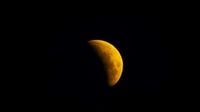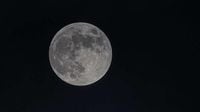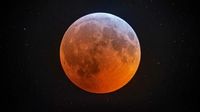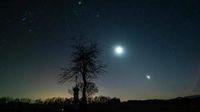As the winter comes to a close, the skies above captivated stargazers around the world with an extraordinary celestial display on March 14, 2025. This date marked a total lunar eclipse that managed to enchant viewers, despite being only partially visible in regions like Germany. Known as the 'Worm Moon' for its arrival at the end of winter, this full moon delivered a spectacular show that included the impressive 'blood moon' phenomenon, a result of the Earth passing directly between the sun and the moon.
During this event, the full moon was entirely obscured by the Earth’s core shadow, transforming its bright surface into an eerie reddish hue. This transformation was vividly evident to observers in North America, where the total eclipse could be seen without hindrance. The humankind's fascination with such celestial events was amplified as photographers documented stunning images of the event, showcasing the moon’s changing colors across different locations.
In contrast, in Germany and other parts of Europe, the totality was less apparent. Although a mere fraction of the moon's surface experienced the eclipse, it sparked similar excitement among local skywatchers. In London, for instance, while the moon was almost entirely eclipsed, German onlookers had only a limited view of the spectacle. But, despite this, many were still enthralled by the glimpse they got as the moon turned a shadowy gray under the Earth's dim light.
As reported, the progression of the lunar eclipse was not merely an astronomical event; it served as a reminder of the roundness of the Earth. The shadow cast on the moon reinforced this fact by presenting a clear curvature, showcasing that our planet is indeed spherical.
The moon's striking transformation into a 'blood moon' had its explanation rooted in atmospheric science. The red color was produced because the sunlight filtering through the Earth's atmosphere during the eclipse scattered shorter wavelengths of light, allowing only the longer red wavelengths to pass through. As a result, viewers beheld a stunning sight between 7:26 AM and approximately 8:31 AM, when the maximum eclipse was reached.
Those lucky enough to be observing the blood moon were treated to a breathtaking sight, as the moon glowed for a full hour in its eclipse phase. The phenomenon lasted from 4:57 AM until the moon was entirely restored to its full brightness around 11:00 AM. Initially marked by the gradual onset of the penumbral phase visible to the naked eye, many stargazers eagerly anticipated the moment when the stronger shadow would cloak their lunar neighbor.
The lunar event wasn’t an isolated one. Just over two weeks later, on March 29, 2025, a partial solar eclipse will take place. During this event, observers in Germany can view the moon as it partially obscures the sun, creating a spectacular visual display of a crescent sun.
Moreover, March 2025 promises further celestial wonders. An exciting planetary alignment of Saturn, Mercury, Neptune, Venus, Uranus, Jupiter, and Mars is also expected around March 2. Stargazers will have a unique opportunity to see these seven planets arranged in the night sky in an awe-inspiring formation.
According to astronomers, the solar phenomenon in March, combined with the blood moon and planetary alignment, showcases the dynamic nature of our night sky and captivates observers of all ages. As Rahlf Hansen, an astronomer at the Planetarium Hamburg, observed, "This significant year for astronomical events, marked by solar storms, can lead to spectacular displays like the northern lights in Germany. Currently, conditions are favorable for viewing these phenomena this March."0 Moreover, for anyone who couldn’t catch these events, another total lunar eclipse will occur on September 7, 2025, providing a second chance to witness such celestial marvels in the near future.
The enthusiasm generated by these events speaks volumes about humanity’s ability to wonder at the cosmos and reveals a deep-seated passion for astronomical occurrences that continue to excite and inspire.
Ultimately, the spectacular display on March 14, 2025, left an indelible mark on the hearts of many. The combination of the blood moon, stunning photographs captured worldwide, and upcoming celestial events like the solar eclipse emphasizes the importance of engaging with the night sky, nurturing our connection to the universe and fostering a sense of wonder about the science behind such mystical moments.
As we look forward to the solar eclipse and anticipate other celestial happenings, it is a reminder that our sky holds mysteries waiting to be unveiled, and every glimpse of the cosmos is a chance to appreciate the beauty and wonder of our universe.




